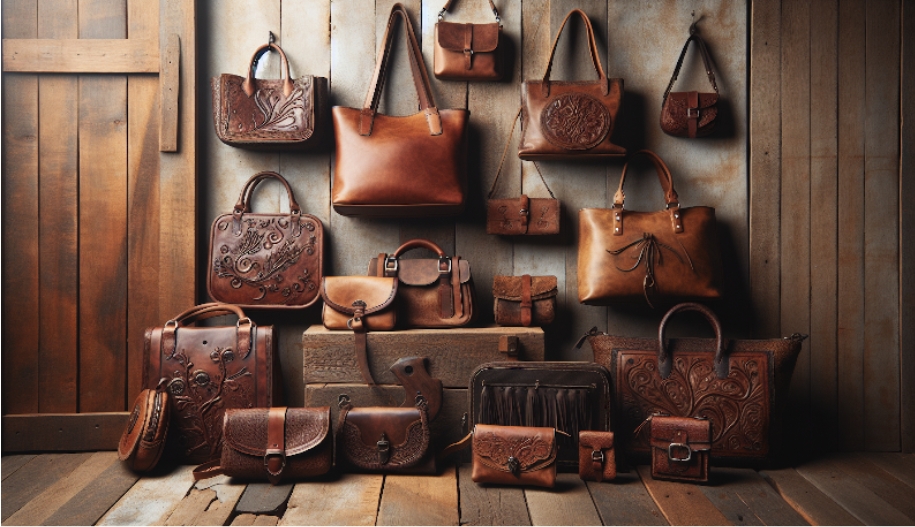Introduction
Leather handbags are a timeless accessory that can elevate any outfit. However, to ensure that your leather handbags remain in pristine condition, it’s essential to give them the proper care and attention they deserve. In this comprehensive guide, we’ll walk you through the best tips and tricks for maintaining your leather handbags, so they continue to look beautiful for years to come.
Understanding Leather Types
Full-Grain Leather
Full-grain leather is the highest quality leather available. It is made from the top layer of the hide and has not been sanded or buffed to remove imperfections. This type of leather is durable, breathable, and develops a beautiful patina over time.
Top-Grain Leather
Top-grain leather is the second-highest quality leather. It is made from the top layer of the hide, but it has been sanded and buffed to remove imperfections and create a more uniform appearance. Top-grain leather is still durable and long-lasting, but it may not develop the same patina as full-grain leather.
Genuine Leather
Genuine leather is a term used to describe any leather that is not full-grain or top-grain. It is usually made from the lower layers of the hide and is often treated with a finish to improve its appearance. Genuine leather is less durable than full-grain or top-grain leather and may not age as well.
Cleaning Your Leather Handbag
Dusting and Wiping
To keep your handbags leather looking its best, it’s important to dust and wipe it down regularly. Use a soft, dry cloth to remove any dust or dirt from the surface of the bag. If there are any stubborn marks or stains, use a slightly damp cloth to gently wipe them away.
Dealing with Stains
If your leather handbag has a stain, it’s important to act quickly. Blot the stain with a clean, dry cloth to remove as much of the substance as possible. Avoid rubbing the stain, as this can spread it and damage the leather. For more stubborn stains, use a leather cleaner specifically designed for your type of leather.
Deep Cleaning
Every few months, it’s a good idea to give your leather handbag a deep clean. Use a leather cleaner and conditioner to remove any dirt or grime that has accumulated over time. Follow the instructions on the product carefully, and be sure to test it on a small, inconspicuous area of the bag first to ensure that it doesn’t cause any discoloration or damage.
Conditioning Your Leather Handbag
The Importance of Conditioning
Leather is a natural material that can dry out and crack over time if not properly conditioned. Conditioning your leather handbag helps to keep the leather soft, supple, and moisturized, preventing it from becoming brittle and prone to damage.
How Often to Condition
How often you need to condition your leather handbag depends on how frequently you use it and the environment it’s exposed to. As a general rule, it’s a good idea to condition your handbag every three to six months, or whenever it starts to feel dry or stiff.
Choosing the Right Conditioner
When choosing a leather conditioner, look for one that is specifically designed for your type of leather. Avoid using products that contain harsh chemicals or alcohol, as these can dry out the leather and cause damage over time. A good leather conditioner should be easy to apply, absorb quickly, and leave the leather feeling soft and supple.
Storing Your Leather Handbag
Stuffing and Shaping
When storing your leather handbag, it’s important to stuff it with tissue paper or a soft cloth to help it maintain its shape. This is especially important for handbags with a structured design, as they can easily become misshapen if not properly supported.
Dust Bags and Storage
To protect your leather handbag from dust, dirt, and other environmental factors, store it in a dust bag when not in use. If you don’t have a dust bag, you can use a soft, breathable fabric like cotton or muslin. Avoid storing your handbag in plastic, as this can trap moisture and cause the leather to deteriorate.
Temperature and Humidity Control
Leather is sensitive to temperature and humidity, so it’s important to store your handbag in a cool, dry place away from direct sunlight and heat sources. Avoid storing your handbag in damp or humid environments, as this can cause mold and mildew to grow on the leather.
Protecting Your Leather Handbag
Waterproofing
To protect your leather handbag from water damage, consider applying a waterproofing spray or cream. These products create a barrier on the surface of the leather that repels water and other liquids, helping to prevent stains and damage.
Avoiding Direct Sunlight
Direct sunlight can cause the color of your leather handbag to fade and the leather to dry out and crack over time. To prevent this, avoid leaving your handbag in direct sunlight for extended periods, and store it in a cool, dry place when not in use.
Handling with Care
To keep your leather handbag looking its best, it’s important to handle it with care. Avoid overstuffing your handbag, as this can cause the leather to stretch and lose its shape. When carrying your handbag, hold it by the handles or straps, rather than by the body of the bag, to prevent unnecessary stress on the leather.
Repairing Your Leather Handbag
Professional Repairs
If your leather handbag has suffered more serious damage, such as a tear or a broken zipper, it’s best to take it to a professional leather repair service. They will have the tools and expertise necessary to repair the damage and restore your handbag to its former glory.
DIY Repairs
For minor repairs, such as a loose thread or a small scratch, you may be able to fix the problem yourself. Use a leather repair kit specifically designed for your type of leather, and follow the instructions carefully. If you’re unsure about how to proceed, it’s always best to consult with a professional.
Conclusion
Caring for your leather handbags is essential to ensuring that they remain beautiful and functional for years to come. By following the tips and tricks outlined in this guide, you can keep your handbags clean, conditioned, and protected from damage. Remember to handle your handbags with care, store them properly, and address any repairs or issues promptly to keep them looking their best.






